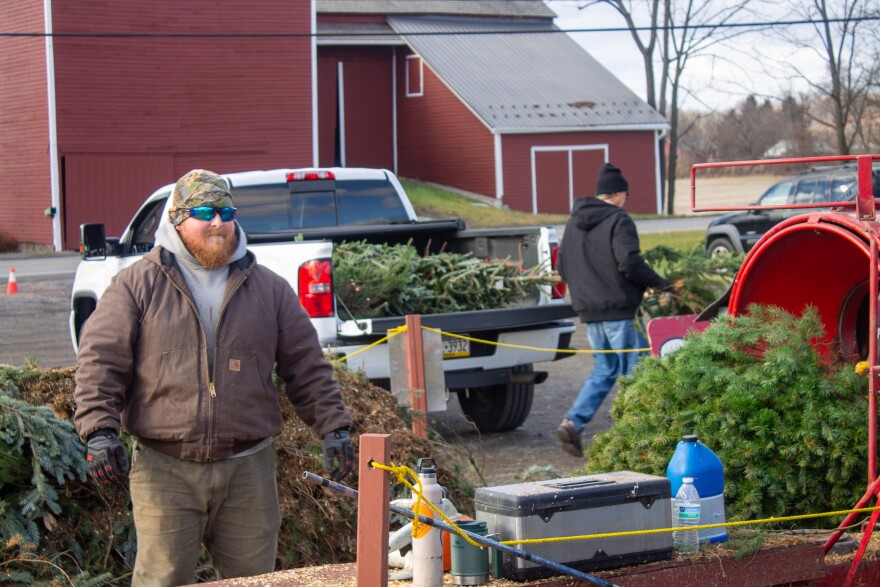BATH, Pa. — In a 192-acre field almost covered in trees that look perfect for Christmas, it's hard to understand how there could be anything close to being described as a "shortage."
There are thousands of trees, many of which look like the perfect size and freshness to string tinsel, ornaments and lights on and load up some presents underneath.
Yet at Unangst Tree Farms in Bath, owner Roger Unangst said this year will be the earliest in the farm's history it has ever sold out of trees — continuing a trend from the previous two years.
"All I can do is guess is that, well, I think everybody was all pent-up in their houses, and not able to get out, but they were able to come to the tree farm and spend some time outside and get a tree. And I believe that was it."Roger Unangst, owner of Unangst Tree Farms in Bath
Unangst said he plans to shutter for the season midway through December. In prior years, sales would go right up until the last minute before Christmas to cater to the procrastinator-types of shoppers, he said.
It's part of a shortage that area Christmas-tree shoppers are seeing, and that some blame on three factors: weather, supply chain issues and COVID-19.
Unangst said one big reason his farm is running out of trees is that buying has increased in recent years.
After COVID-19-related lockdowns, Unangst said, his Christmas tree sales jumped 15% from 2021 onward.
"All I can do is guess is that, well, I think everybody was all pent-up in their houses, and not able to get out, but they were able to come to the tree farm and spend some time outside and get a tree," he said.
"And I believe that was it."
Other fluctuations in Christmas Tree supply have always been manageable, he said, but the extra 15% demand after COVID-19 tipped the scales.
Unangst said the bulk of tree sales from his farm happened before December, on Black Friday.
"We opened at 9, and by about 10:40 a.m., we were out," he said. At the end of this week, the farm is scheduled to shut down its pick-your-own-tree operations, but still will sell trees out of its pre-cut lot.
Other factors
In addition to the effects of the coronavirus pandemic, weather can affect how many Christmas trees are available.
The past decade has been a drier one, which means less water to help the trees grow. That has effects that don't kick in until nearly 10 years later.
So drier weather prevalent in the Lehigh Valley around 2013 is partially to blame for why you can't easily find a Christmas tree today, Unangst said.

Other weather factors include surges in frost, which can decimate rows and rows of Unangst's trees at a time, sometimes on a single cold night.
That diminishes stock, and sometimes its effects also don't kick in for years. For example, a cold, frosty winter in 2013-14 could have knocked out the exact tree you were going to buy this year.
"I mean, it depends how you define shortage. There's no shortage of trees. If you want a real Christmas tree, you'll be able to buy a real Christmas tree. Are you going to be able to buy the exact tree that you want? Is it going to be a 7-foot-tall Douglas Fir? I don't know — probably not. At least not at this stage."Aaron Grau, executive director, Pennsylvania Christmas Tree Growers Association
Regarding supply chains, disruptions seen in the past few years (truck labor shortages, strikes, traffic issues, etc.) can impede the ability for farms to bring in supplemental trees if they were to run out.
Unangst said it's something his farm has used, but sparingly.
Some also suggest inflation and coronavirus pandemic-related problems with overseas shipping of artificial trees may have caused a spike in demand for real ones.

'Crystal ball' betrays him
Unangst said it's impossible to plan with 100% success in the Christmas Tree trade.
"I always tell people, my crystal ball is broken and I haven't quite gotten it right yet," Unangst said with a hearty chuckle. "Oh yeah, I've been doing this for 39 years and you're thinking eight, nine years out.
"You're thinking the number of trees you're going to be selling at that point, and you're thinking the variety of trees you're going to be selling. What's the hot variety? What's popular, and what's not popular anymore? There's a lot of guessing."

On top of the delicate, ever-rolling balance of maintaining all the usual different sizes of tree over the span of decades, there also are evolving trends in types of tree, such as Douglas Fir, Fraser Fir and even some one-hit-wonder brands such as White Pine, which had a surge of popularity in the early 2000s, but fell out of favor because they leave a mess everywhere, and are tough to hang ornaments on.
"We sell around 7,000 trees a year. You know, when your family has a Christmas, maybe you have your in-laws, your neighbors, and maybe a few other family members or friends take part...but Christmas here, we're part of 7,000 Christmases, and we're pretty lucky."Roger Unangst, owner of Unangst Tree Farms
But if there's a shortage, with all the trees on his farm, why not chop them down, sell them and put them in living rooms?
Because: every single one of the thousands of trees has a specific date and time it's slotted to be chopped down, and it fits into a grand plan that spans decades, Unangst said.
They take up to 10 years to grow to full size — and different sizes need to be offered. Some people like taller trees, while some people, as in the cartoon "Merry Christmas, Charlie Brown," famously prefer shorter ones.
Another perspective: 'No shortage'
Asked about the Christmas tree shortage, Aaron Grau, executive director of the Pennsylvania Christmas Tree Growers Association, initially said via email: "There is no shortage."
After hearing Unangst's perspective, he offered some caveats.
"I mean, it depends how you define shortage," Grau said in a phone call. "There's no shortage of trees; if you want a real Christmas tree, you'll be able to buy a real Christmas tree.

"Are you going to be able to buy the exact tree that you want? Is it going to be a 7-foot-tall Douglas Fir? I don't know — probably not. At least not at this stage.
"But let's say you do find it, are you going to pay the price you want to pay? Maybe the price you paid last year? Probably not. Prices have gone up. Does that mean there's a shortage? I guess it depends on how you look at it."

Unangst responded, "Well, I respectfully disagree. Tree lots are selling out and closing the earliest they ever have. How does that translate into there's no shortage?"
Unangst also theorized the state tree growers association may be in a different part of the state — and it is, in Pittsburgh.
Grau conceded that influences its perspective.
"So, I mean, I'm quite certain that in some areas where there are perhaps fewer growers or fewer real-tree retailers," Grau said. "Yeah, I can see people closing up sooner.
"That still doesn't mean there isn't a real tree out there for someone who wants to buy one.
"The perspectives that I have are definitely different than a grower in the Lehigh Valley.
"So my only respectful pushback would be that overall, in the state of Pennsylvania and in the country, really there still is no shortage. Distribution of inventory is going to be an issue, but there's still a tree out there if you want to find one."
'We work together'
At Unangst Tree Farms, Unangst said he has no problem recommending other tree sellers who could be considered his competitors.
"We're all friendly," he said. "We go to trade shows and seminars together, we work together."
For anyone looking for a recommendation on where to get a tree when he runs out, he suggested visiting the farm's website and checking for updates.
Summing up his relationship with Christmas, Unangst thought about it for a minute. He pointed to the lot where the trees are sold.
"We sell around 7,000 trees a year," he said. "You know, when your family has a Christmas, maybe you have your in-laws, your neighbors, and maybe a few other family members or friends take part.
"But Christmas here — we're part of 7,000 Christmases, and we're pretty lucky."


